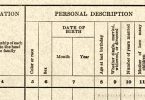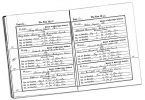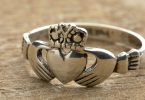Sometimes, you may not find a marriage record, but you will find a marriage bond. In fact, marriage records are more of a recent invention, becoming common in the mid to late 1800s. Prior to that, marriage bonds were the far more usual way of recording marriages in early American communities (and sometimes in European ones). What is the difference between a marriage record and a marriage bond? Is one type of record better than the other for genealogy research? This is what you need to know about these records.
First of all, it is important to know that the existence of a marriage bond does not necessarily mean a marriage took place (although it probably does). A bond is an official notice of an intent to marry. The groom, and usually one of his friends or relatives, too, had to put down a monetary amount to secure this bond, kind of like how people post bond to get people out of jail. Just like if someone jumps bail and the person who paid doesn’t get their bail money back, the same was true for the groom and the person vouching for him. If there was later found to be a legal reason why he and/or the bride could not get married, his bond money was not returned to him. It was the monetary equivalent of someone objecting to a marriage at the ceremony.
You might, for example, find that the groom and his brother made a marriage bond that promised to pay the governor of their colony or state a sum of five hundred pounds. Within the bond would usually be a caveat that the promise to pay this sum would be voided if no legal impediment to the marriage was discovered and the marriage took place.
The name of the person who signs onto the bond with the groom often offers an excellent clue as to who else’s records to look into to find more information on this branch of your family tree.
As with marriage records (also sometimes referred to as marriage licenses), the type of information you may find in a marriage bond will vary according to the time and place it was created. These are some of the useful pieces of information you may or may not find in a marriage bond.
The Name of the Groom—This was almost always included on a marriage bond, as the prospective groom was one of two people promising to pay if the marriage was found to be illegal.
The Bondsman—This is the person who vouched for the groom with his own money, and was usually a friend or close relative of the groom. Names like these always provide clues of where else and who else you can search to add information to your family tree.
The Location—This is where the bond was signed. Usually, just the county is mentioned. The bond is made in the county where the groom lives, and is usually where the marriage is intended to take place (but, not always). You can research this county for more ancestors.
The Date of the Bond—The bond is usually made not too long before the marriage. Even if you don’t find an official marriage record, this date will give you a general idea of when the couple was married.
The Name of the Bride—Sometimes, it’s not included in the bond. If it is, she may be referred to only by her first name, or only by her maiden name, as in “Miss Johnson.” If any part of her name is included and you didn’t have a name before, you now have more information to help you find the full name of the bride. If you’re lucky, her full name will be on the bond.
Signatures of the Groom, Bondsman, and Witnesses—Along with showing you whether your ancestor could write (depending on if he signed his name with an X or signed his whole name), you will also find names of possible close friends or family members you can research in the names of the witnesses.




